Crank J. Free and Moving Boundary Problems
Подождите немного. Документ загружается.

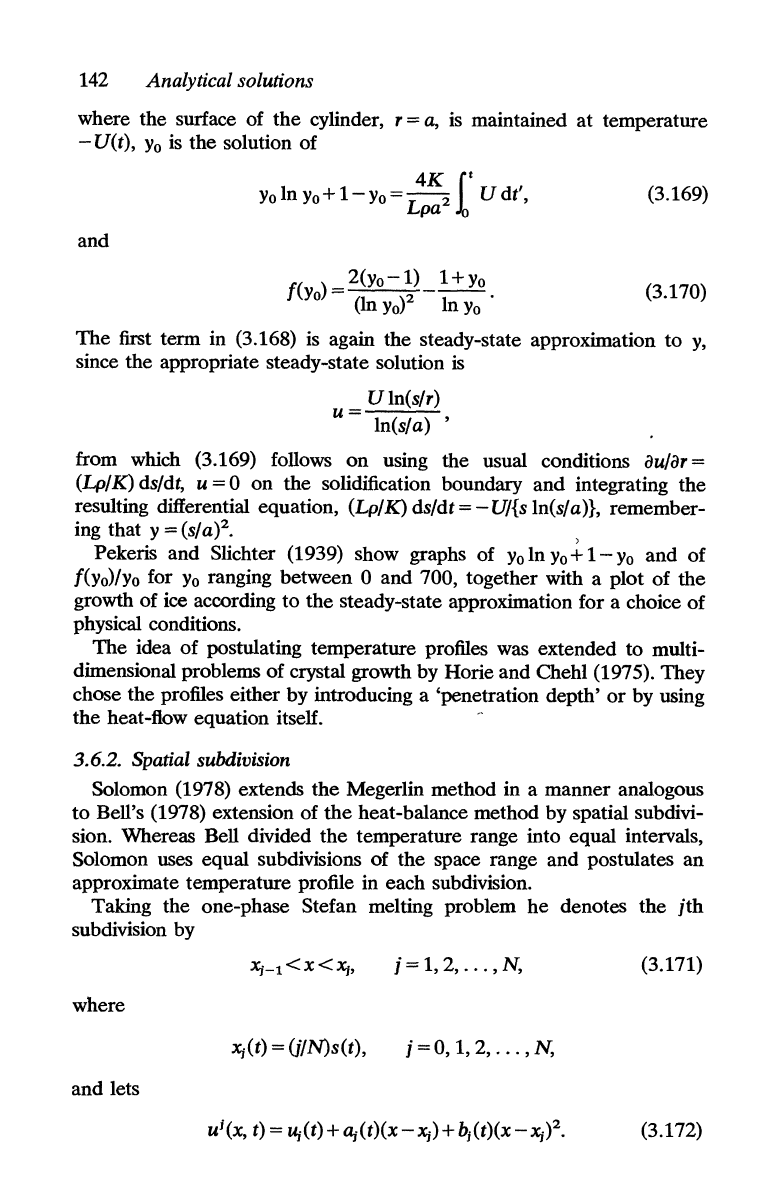
142
Analytical solutions
where the surface of the cylinder, r =
a,
is
maintained at temperature
- U(t),
Yo
is
the solution of
and
4K
f'
yolnyo+1-Yo=Lpa2-'o
Udt',
(3.169)
(3.170)
The
first
tenn
in (3.168)
is
again the steady-state approximation to
y,
since the appropriate steady-state solution
is
u=
U In(s/r)
In(s/a) ,
from which (3.169) follows
on
using the usual conditions
au/ar=
(Lp/K)
ds/dt, u = 0 on the solidification boundary
and
integrating the
resulting differential equation,
(Lp/K)
ds/dt = - U/{s In(s/a)}, remember-
ing that
y = (s/a)2. )
Pekeris and Slichter (1939) show graphs of
Yo
In
Yo
+ 1 -
Yo
and of
f(yo)/Yo for
Yo
ranging between 0 and 700, together with a plot of the
growth of ice according
to
the steady-state approximation for a choice of
physical conditions.
The
idea of postulating temperature profiles was extended to multi-
dimensional problems of crystal growth by Horie and Chehl (1975). They
chose the profiles either by introducing a 'penetration depth'
or
by using
the heat-flow equation itself.
3.6.2. Spatial subdivision
Solomon (1978) extends
the
Megerlin method in a manner analogous
to
Bell's (1978) extension of
the
heat-balance method by spatial subdivi-
sion. Whereas Bell divided
the
temperature range into equal intervals,
Solomon uses equal subdivisions of the space range and postulates
an
approximate temperature profile in each subdivision.
Taking the one-phase Stefan melting problem
he
denotes the
jth
subdivision by
Xj-l
<x<Xj,
j=1,2,
...
,N,
(3.171)
where
Xj(t) =
(jfN)s(t),
j = 0, 1, 2,
...
,
N,
and lets
(3.172)
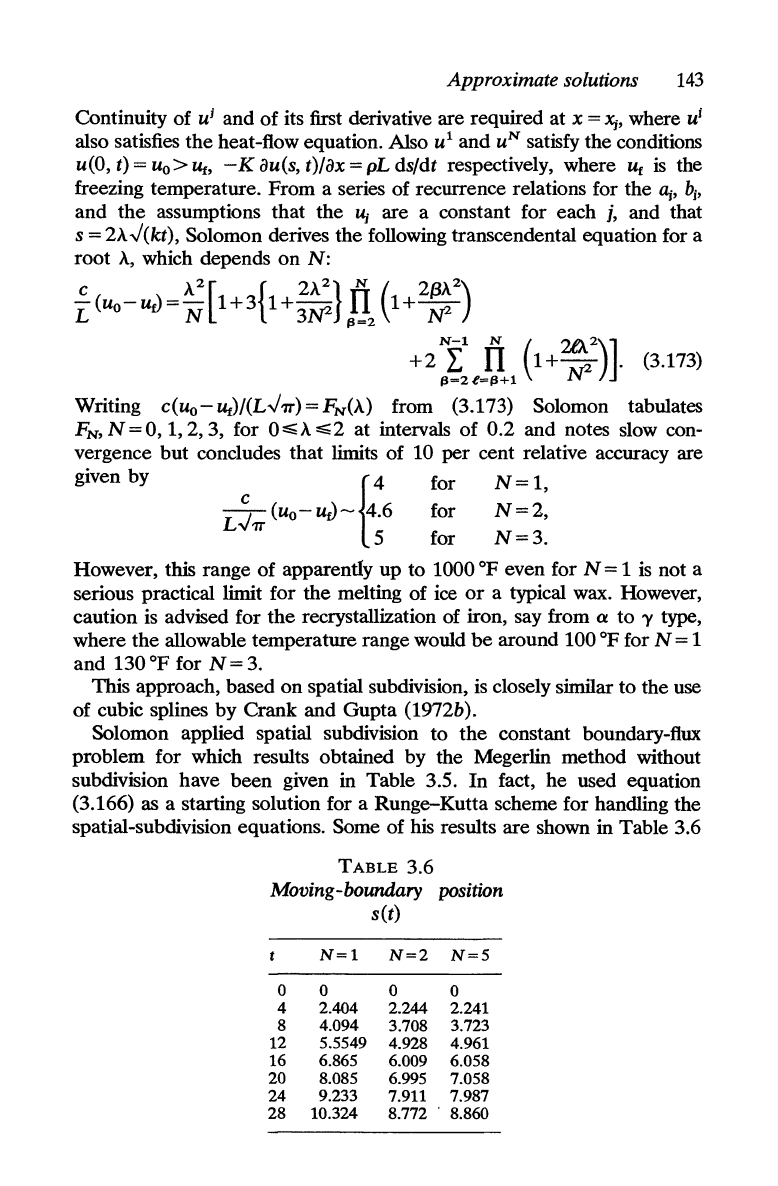
Approximate solutions
143
Continuity of u
i
and of its first derivative are required at x = Xj, where u
i
also satisfies
the
heat-flow equation. Also u
1
and
UN
satisfy the conditions
u(O, t) =
Uo>
Ut,
- K
dU(S,
t)/dX =
pL
ds/dt respectively, where
Uf
is
the
freezing temperature. From a series of recurrence relations for the
llj, b
j
,
and the assumptions that the
Uj
are a constant for each j, and that
s
=
2A
.J(kt), Solomon derives the following transcendental equation for a
root
A,
which depends on
N:
C A
2
[ {
2A
2
} N (
2{3A
2)
L
(Uo-uJ=
N
1+3
1+
3~
11
1
+
N2
N-l
N (
UA2)]
+2
L
11
1+-
. (3.173)
/3=2t'=/3+1
~
Writing
c(Uo-Ut)/(L.J7T)=F
N
(A) from (3.173) Solomon tabulates
FN,N=O,
1,2,3,
for
0:,;;:;A.;;;2
at intervals of 0.2 and notes slow con-
vergence but concludes that
limits of 10
per
cent relative accuracy are
given by
f4
for
N=
1,
L~1T
(uo-uJ-
4
5
.6 for
N=2,
for
N=3.
However, this range of apparently up to 1000
OF
even for N = 1
is
not a
serious practical limit for
the
melting of ice
or
a typical wax. However,
caution is advised for
the
recrystallization of iron, say from a
to
'Y
type,
where the allowable temperature range would
be
around 100
OF
for N = 1
and 130
OF
for N =
3.
This approach, based on spatial subdivision,
is
closely similar to the use
of cubic splines by Crank and Gupta
(1972b).
Solomon applied spatial subdivision to
the
constant boundary-flux
problem for which results obtained by the Megerlin method without
subdivision have been given in Table 3.5.
In
fact, he used equation
(3.166) as a starting solution for a Runge-Kutta scheme for handling the
spatial-subdivision equations. Some of his results are shown in Table 3.6
TABLE
3.6
Moving-boundary
position
s(t)
N=1
N=2
N=5
0 0 0
0
4
2.404
2.244 2.241
8 4.094
3.708
3.723
12 5.5549
4.928 4.961
16 6.865
6.009 6.058
20 8.085 6.995 7.058
24
9.233
7.911 7.987
28 10.324 8.772
' 8.860
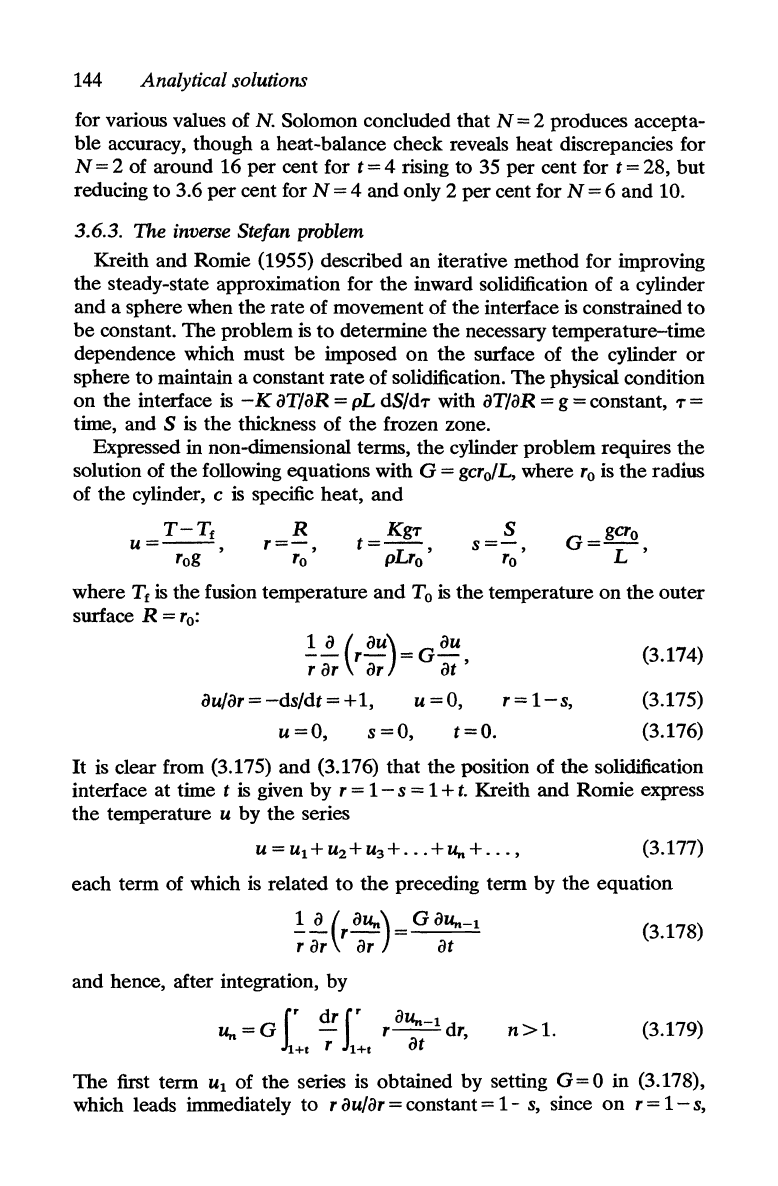
144
Analytical solutions
for various values
of
N. Solomon concluded
that
N
==
2 produces accepta-
ble accuracy, though a heat-balance check reveals
heat
discrepancies for
N
= 2 of around
16
per
cent for t = 4 rising to 35
per
cent for t = 28,
but
reducing
to
3.6
per
cent for N = 4
and
only 2
per
cent for N = 6
and
10.
3.6.3.
The inverse Stefan problem
Kreith
and
Romie (1955) described
an
iterative
method
for improving
the
steady-state approximation for
the
inward solidification
of
a cylinder
and
a sphere when
the
rate
of
movement
of
the
interface is constrained
to
be
constant.
The
problem is
to
determine
the
necessary
temperature-time
dependence which must
be
imposed
on
the
surface
of
the
cylinder
or
sphere
to
maintain a constant
rate
of
solidification.
The
physical condition
on
the
interface is - K aTtaR =
pL
dS/d-T
with aTtaR = g = constant, T =
time,
and
S is
the
thickness
of
the
frozen zone.
Expressed in non-dimensional terms,
the
cylinder
problem
requires
the
solution
of
the
following equations with G = gcro/L, where
ro
is
the
radius
of
the
cylinder, c is specific
heat,
and
T-T
f
u=--
rog ,
R
r=-
ro'
KgT
t=--
pLro'
S
s=-,
ro
G=gcr
o
L'
where
T
f
is the fusion
temperature
and
To
is
the
temperature
on
the
outer
surface R =
ro:
!~
(r
au) = G au,
r
ar
ar
at
au/ar=
-ds/dt=
+1, u
=0,
r=
1-s,
u=o, s=o,
t=O.
(3.174)
(3.175)
(3.176)
It
is clear from (3.175)
and
(3.176)
that
the
position
of
the
solidification
interface
at
time t is given
by
r = 1 - s = 1 +
t.
Kreith
and
Romie express
the
temperature u
by
the
series
(3.177)
each
term
of
which is related
to
the
preceding
term
by
the
equation
!~(r
au,,) = G au,,-1 (3.178)
r
ar
ar
at
and
hence, after integration,
by
u,,=G
r
drI'
J
1
+
t
r
1+t
au,,-1 d
r--
r
at
'
n>l.
(3.179)
The
first term U1
of
the
series is
obtained
by
setting G = 0
in
(3.178),
which leads immediately
to
r
au/ar
= constant = 1 - s, since
on
r = 1 - s,
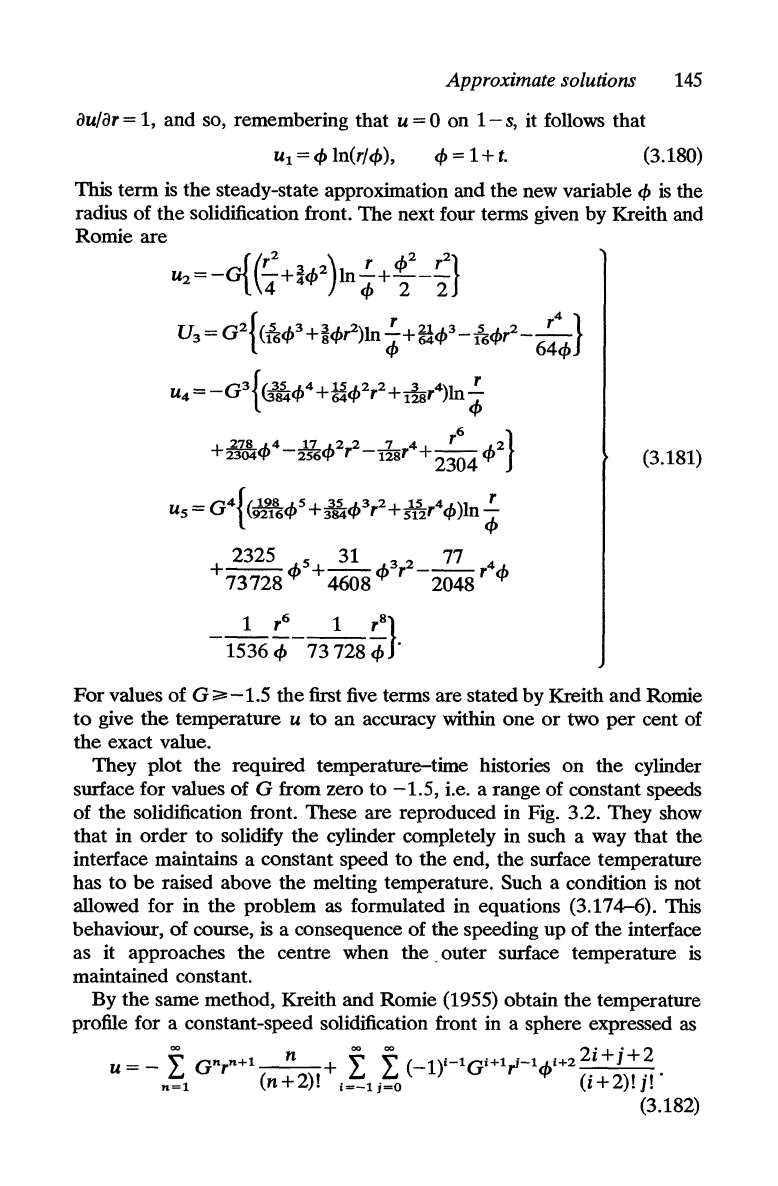
Approximate solutions
145
au/ar
= 1, and so, remembering that u = 0 on
1-
s,
it follows that
U1
=
</>
In(r/</»,
</>=1+t.
(3.180)
This term
is
the steady-state approximation and the new variable
</>
is
the
radius of the solidification front. The next four terms given by Kreith and
Romie are
r<1(r2
) r
</>2
r2}
U2=-'l
4+~</>2
In
</>
+"2-2"
U
3
=
G2{(-&</>3+i</>~)ln
.!:.+~</>3_-&</>r2_~}
</>
64</>
U4
=
-G
3
{
C31f4</>4
+
H</>2r2
+ rlsr4)ln ;
~-I.4
.l1.
2 2 7 4
r6
2}
+
2304'1'
-
256</>
r -
128
r
+ 2304
</>
_
G4{(.l2.a.-I.5+~-I.3
2+..12.
4-1.)1
r
Us
-
9216'1'
384'1'
r
512
r
'I'
n
</>
2325 5 31 3 2
77
4
+ 73728
</>
+ 4608
</>
r - 2048 r
</>
1r
6
1
r8}
1536
</>
73 728
</>
(3.181)
For
values of
G;;;;.
-1.5
the
first
five
terms are stated by Kreith
and
Romie
to
give
the
temperature U to an accuracy within one
or
two
per
cent of
the exact value.
They plot the required temperature-time histories on the cylinder
surface for values of G from zero to
-1.5,
i.e. a range of constant speeds
of the solidification front. These are reproduced in Fig. 3.2. They show
that in order
to
solidify the cylinder completely in such a way that the
interface maintains a constant speed
to
the end, the surface temperature
has
to
be raised above the melting temperature. Such a condition
is
not
allowed for in the problem as formulated in equations
(3.174-6). This
behaviour, of course,
is
a consequence of the speeding up of the interface
as it approaches the centre when
the.
outer surface temperature
is
maintained constant.
By the same method, Kreith and Romie
(1955) obtain
the
temperature
profile for a constant-speed solidification front in a sphere expressed as
U = _
~
G
n
r
n
+
1
n
,+
~ ~
(_
W-1Gi+1ri-1</>i+2
2.i
+ j
~
~
.
n=l
(n+2).
i=-lj=O
(,+2).J.
(3.182)
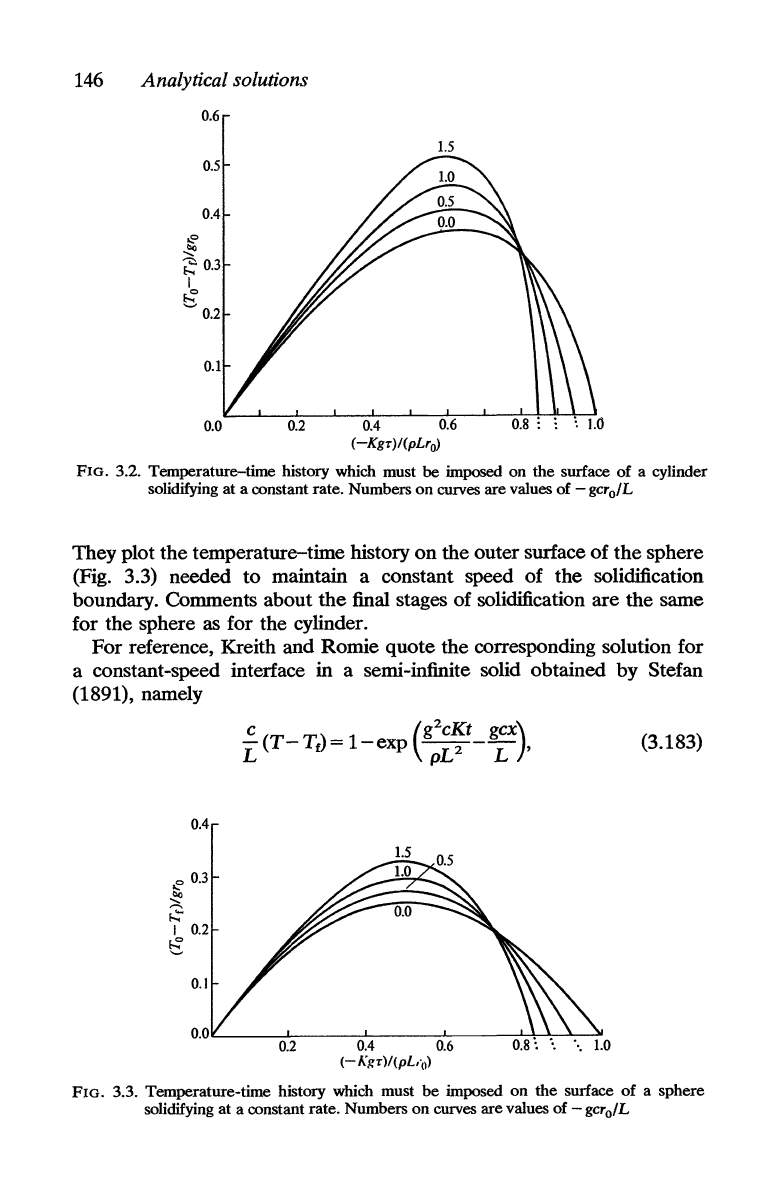
146
Analytical solutions
~
~
0.6
0.5
0.4
~
0.3
I
~
~
0.2
1.5
0.2
0.4 0.6
(-Kgr)/(pLro)
FIG. 3.2. Temperature-time history which must
be
imposed on the surface of a cylinder
solidifying at a constant rate. Numbers
on
curves are values of
-gcro/L
They plot the temperature-time history on the outer surface of
the
sphere
(Fig. 3.3) needed to maintain a constant speed of
the
solidification
boundary. Comments about
the
final stages of solidification are the same
for the sphere as for the cylinder.
For reference, Kreith and Romie quote the corresponding solution for
a constant-speed interface in a semi-infinite solid obtained by Stefan
(1891), namely
0.4
e
0.3
~
~
I
0.2
C
0.1
c
(g2cKt
gCX)
-(T-T
f
)=1-exp
----
L
pL
2
L'
(3.183)
0.2
0.4
0.6
(-
K[:r)/(pLio)
FIG. 3.3. Temperature-time history which must be imposed on the surface
of
a sphere
solidifying at a constant rate. Numbers
on
curves are values of - gcro/L
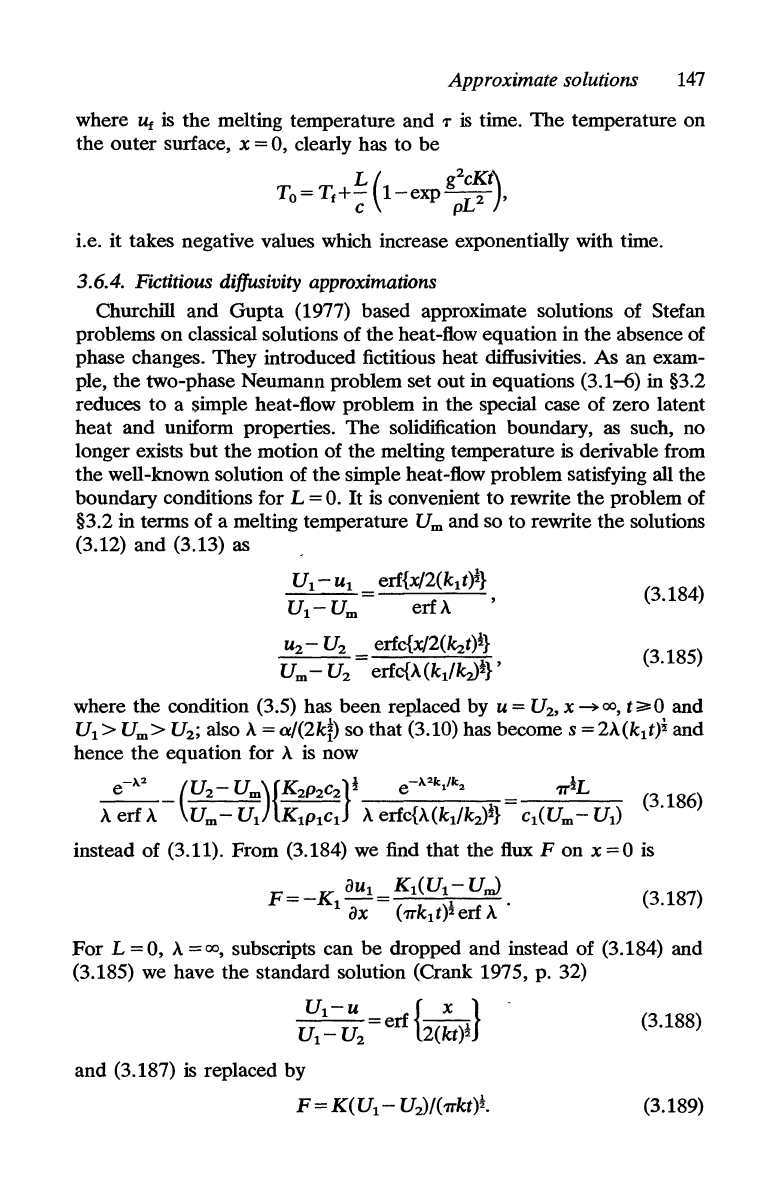
Approximate solutions
147
where
U£
is
the
melting temperature and T
is
time.
The
temperature
on
the
outer
surface, x = 0, clearly has
to
be
L (
g2
c
Kt\
To=Tf+;
1-exp
pL
2
)'
i.e.
it
takes negative values which increase exponentially with time.
3.6.4. Fictitious diffusivity approximations
Churchill
and
Gupta
(1977) based approximate solutions of Stefan
problems
on
classical solutions of
the
heat-flow equation in the absence of
phase changes. They introduced fictitious heat diffusivities.
As
an
exam-
ple,
the
two-phase Neumann problem set out in equations (3.1-6) in §3.2
reduces
to
a simple heat-flow problem in
the
special case
of
zero latent
heat
and
uniform properties.
The
solidification boundary, as such, no
longer exists
but
the
motion
of
the melting temperature is derivable from
the
well-known solution of
the
simple heat-flow problem satisfying all the
boundary conditions for
L =
O.
It is convenient
to
rewrite
the
problem
of
§3.2 in terms
of
a melting temperature U
m
and so
to
rewrite the solutions
(3.12) and (3.13) as
U
1
-
Ul
erf{x/2(klt)~}
U
1
-
U
m
erfA
U2
- U
2
_
erfc{x/2(~t)!}
U
m
-U
2
-
erfc{A(kl/~~}'
(3.184)
(3.185)
where
the
condition (3.5) has
been
replaced by U = U
2
, X
~CO,
t ... O and
U
1
>
Um>
U
2
;
also A
=a/(2kt)
so that (3.10) has become s
=2A(k
1
t);
and
hence
the
equation for A is now
_e___
2 - m
2P2
C
2
e 1 2
'IT
(3 186)
-).2
(U
U
){K
}!
-).2k
/k
!L
A erf A U
m
-
U
1
K1PICl
A erfc{A(k
1
/k
2
)!}
Cl(U
m
-
U
1
) •
instead of (3.11). From (3.184) we find that the flux F on x = 0 is
F=-K
1
aUl=Kl(U\-U~.
(3.187)
ax
(-7Tk
1
t)"erf A
For
L = 0, A = co, SUbscripts can
be
dropped and instead
of
(3.184) and
(3.185) we have
the
standard solution (Crank 1975, p. 32)
U1-u
{X}
U
1
-
U
2
erf
2(kt)!
(3.188)
and
(3.187) is replaced by
F =
K(
U
1
-
U
2
)/(
'lTkt)t.
(3.189)
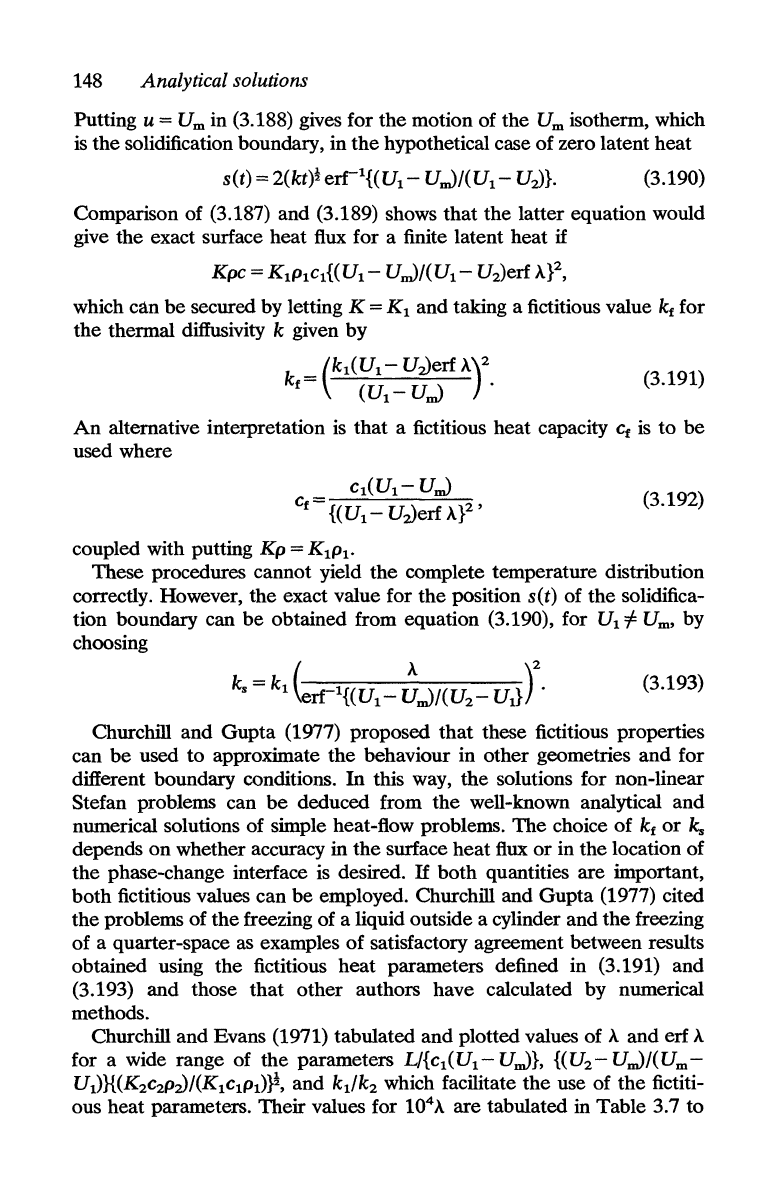
148
Analytical solutions
Putting u =
Urn
in (3.188) gives for
the
motion
of
the
Urn
isotherm, which
is
the
solidification boundary, in
the
hypothetical case
of
zero latent
heat
(3.190)
Comparison
of
(3.187)
and
(3.189) shows
that
the
latter equation would
give
the
exact surface
heat
flux for a finite latent
heat
if
Kpc = KIPICI{(U
I
-
U~/(UI-
U
2
)erf
AV,
which can
be
secured by letting K =
KI
and
taking a fictitious value k
f
for
the
thermal diffusivity k given
by
k =
(kl(U
I
-
U~erf
,\.)2
f
(UI-U~
.
(3.191)
An
alternative interpretation is
that
a fictitious
heat
capacity
Cf
is
to
be
used where
CI(UI-U~
Cf =
{(UI
-
U~erf
,\.}2 ,
(3.192)
coupled with putting
Kp
=
KIPI'
These
procedures cannot yield
the
complete temperature distribution
correctly. However,
the
exact value for
the
position s(t) of
the
solidifica-
tion boundary can
be
obtained from equation (3.190), for U
I
=/=
Urn,
by
choosing
k. = ki
~rrl{(UI-
~~/(U2-
UI}t
(3.193)
Churchill
and
Gupta
(1977) proposed
that
these fictitious properties
can
be
used
to
approximate
the
behaviour in
other
geometries
and
for
different boundary conditions.
In
this way,
the
solutions for non-linear
Stefan problems can
be
deduced from
the
well-known analytical
and
numerical solutions of simple heat-flow problems.
The
choice
of
k
f
or
k.
depends
on
whether accuracy in
the
surface
heat
flux
or
in
the
location of
the
phase-change interface is desired. H
both
quantities
are
important,
both
fictitious values
can
be
employed. Churchill and
Gupta
(1977) cited
the
problems of
the
freezing
of
a liquid outside a cylinder and
the
freezing
of
a quarter-space as examples
of
satisfactory agreement between results
obtained using
the
fictitious
heat
parameters defined
in
(3.191)
and
(3.193)
and
those
that
other
authors
have
calculated by numerical
methods.
Churchill
and
Evans (1971) tabulated
and
plotted values of
,\.
and
erf,\.
for a wide range of
the
parameters
L/{CI(U
I
-
U~},
{(U
2
-
U~/(Um
UI)){(K2C2P~/(KICIPI)}!'
and
kIlk2
which facilitate
the
use of
the
fictiti-
ous
heat
parameters.
Their
values for
104,\.
are
tabulated in
Table
3.7
to
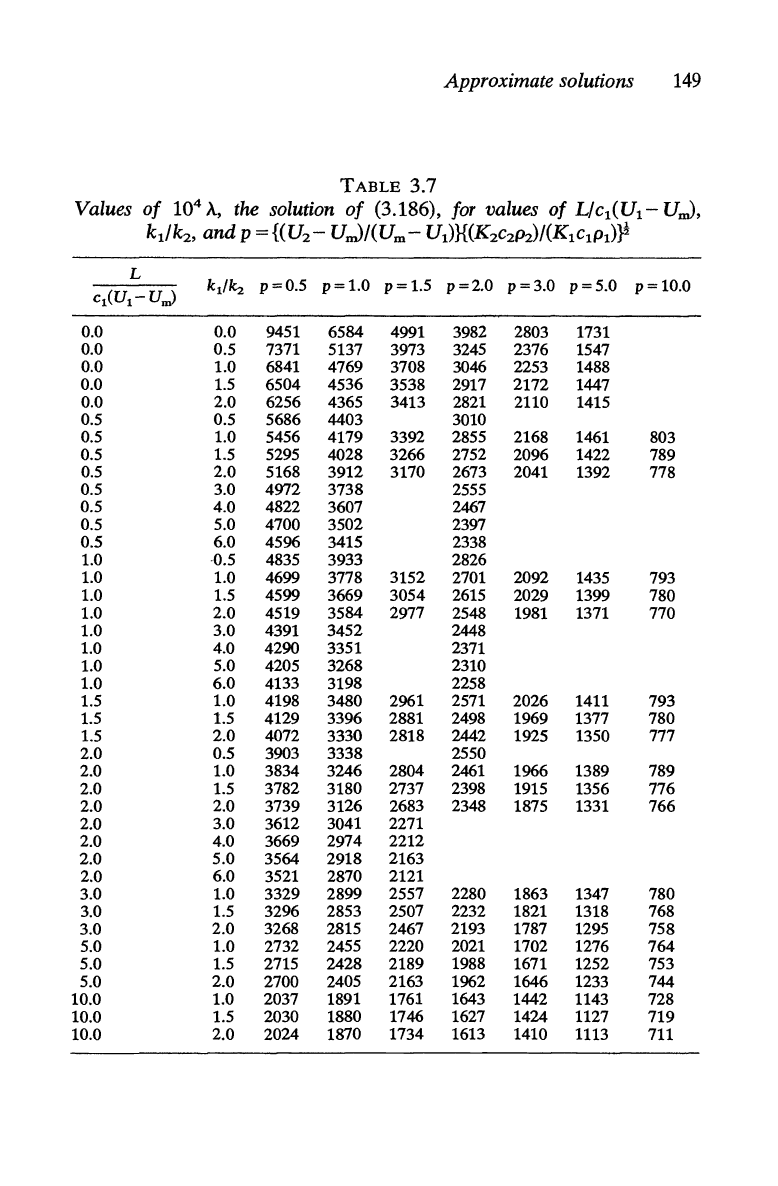
Approximate solutions
149
TABLE
3.7
Values
of
10
4
A,
the solution
of
(3.186),
for
values
of
L/C
1
(U
1
-
Urn),
kl/k2'
and p
={(U
2
-
UrJ/(U
m
-
Ul)}{(K2C2P2)/(KlClPl)}~
L
C1(UI-UrJ
kl/k2
p=0.5
p=1.0
p=1.5
p=2.0
p=3.0 p=5.0
p=10.0
0.0
0.0
9451
6584
4991
3982
2803
1731
0.0 0.5
7371
5137
3973
3245
2376
1547
0.0
1.0
6841
4769
3708
3046
2253
1488
0.0
1.5
6504 4536
3538
2917
2172
1447
0.0
2.0
6256
4365
3413
2821
2110
1415
0.5
0.5
5686 4403
3010
0.5
1.0
5456
4179
3392
2855
2168
1461
803
0.5 1.5
5295
4028
3266
2752
2096
1422
789
0.5
2.0
5168
3912
3170
2673 2041
1392
778
0.5
3.0
4972 3738
2555
0.5
4.0
4822
3607
2467
0.5
5.0
4700
3502
2397
0.5 6.0 4596
3415
2338
1.0
0.5
4835
3933
2826
1.0
1.0
4699
3778
3152
2701
2092
1435
793
1.0
1.5
4599
3669 3054
2615
2029
1399
780
1.0
2.0
4519
3584
2977
2548
1981 1371
770
1.0
3.0
4391
3452
2448
1.0
4.0
4290
3351
2371
1.0
5.0
4205
3268
2310
1.0
6.0
4133
3198
2258
1.5
1.0
4198
3480
2961
2571
2026
1411
793
1.5
1.5
4129 3396
2881
2498
1969 1377
780
1.5
2.0
4072
3330
2818
2442
1925 1350
777
2.0
0.5
3903
3338
2550
2.0
1.0
3834
3246
2804
2461
1966 1389
789
2.0
1.5
3782 3180
2737
2398
1915 1356
776
2.0
2.0
3739 3126
2683
2348
1875
1331
766
2.0
3.0
3612 3041
2271
2.0
4.0
3669
2974 2212
2.0
5.0
3564 2918
2163
2.0
6.0
3521
2870
2121
3.0
1.0
3329 2899
2557
2280
1863 1347
780
3.0
1.5
3296
2853
2507
2232
1821
1318
768
3.0
2.0
3268
2815
2467
2193
1787
1295
758
5.0
1.0
2732
2455
2220
2021
1702
1276
764
5.0
1.5
2715
2428
2189
1988
1671
1252
753
5.0
2.0
2700
2405
2163
1962
1646
1233
744
10.0
1.0
2037
1891 1761
1643
1442
1143
728
10.0
1.5
2030
1880
1746 1627
1424
1127
719
10.0
2.0
2024
1870
1734
1613
1410 1113
711
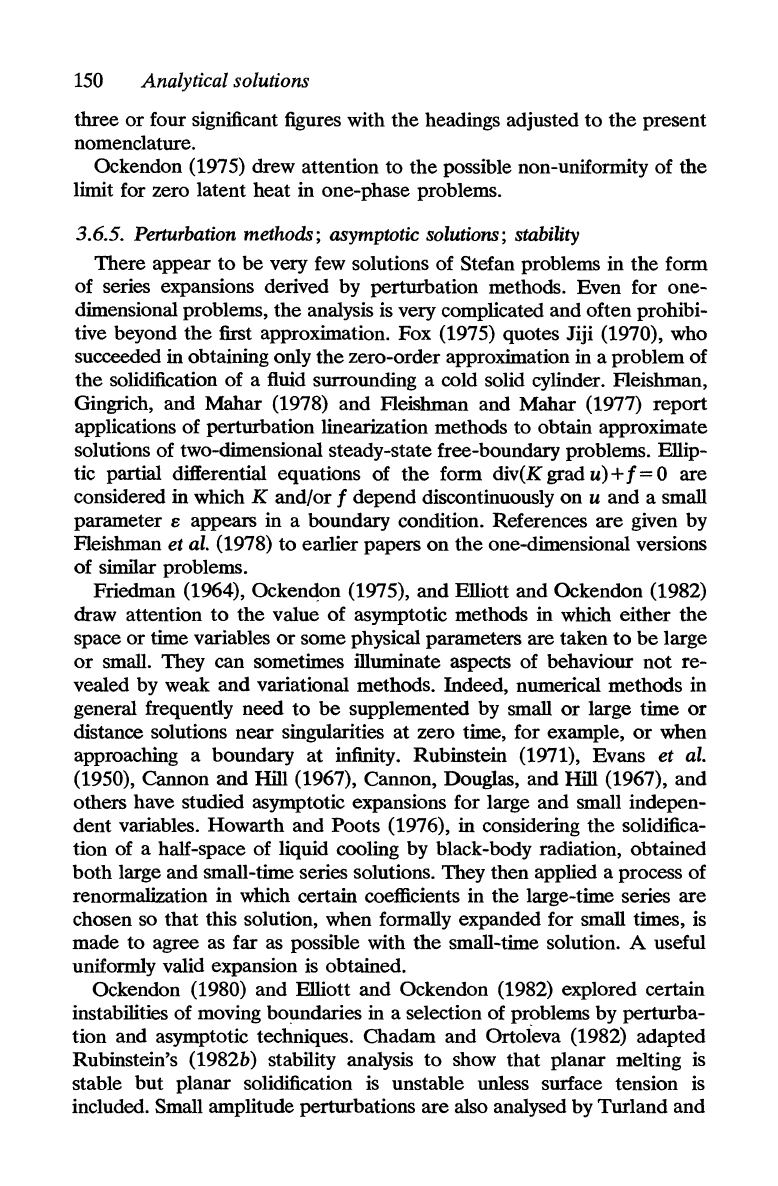
150 Analytical solutions
three
or
four significant figures with
the
headings adjusted
to
the
present
nomenclature.
Ockendon (1975) drew attention to
the
possible non-unifonnity of
the
limit for zero latent
heat
in one-phase problems.
3.6.5. Perturbation methods; asymptotic solutions; stability
There
appear
to
be
very few solutions of Stefan problems in
the
form
of series expansions derived by perturbation methods. Even for
one-
dimensional problems, the analysis
is
very complicated and often prohibi-
tive beyond
the
first approximation. Fox (1975) quotes Jiji (1970), who
succeeded in obtaining only
the
zero-order approximation in a problem
of
the solidification of a fluid surrounding a cold solid cylinder. Fleishman,
Gingrich, and
Mahar
(1978) and Fleishman and Mahar (1977)
report
applications of perturbation linearization methods to obtain approximate
solutions of two-dimensional steady-state free-boundary problems. Ellip-
tic partial differential equations of
the
form div(K grad u) + f = 0
are
considered in which K and/or f depend discontinuously
on
u and a small
parameter e appears in a boundary condition. References
are
given by
Fleishman
et al. (1978) to earlier papers
on
the
one-dimensional versions
of similar problems.
Friedman (1964), Ockendon (1975), and Elliott and Ockendon (1982)
draw attention
to
the
value
of
asymptotic methods in which either
the
space
or
time variables
or
some physical parameters are taken
to
be
large
or
small. They can sometimes illuminate aspects of behaviour
not
re-
vealed by weak and variational methods. Indeed, numerical methods in
general frequently need
to
be
supplemented by small
or
large time
or
distance solutions near singularities
at
zero time, for example,
or
when
approaching a boundary
at
infinity. Rubinstein (1971), Evans
et
al.
(1950), Cannon and
Hill
(1967), Cannon, Douglas, and
Hill
(1967), and
others have studied asymptotic expansions for large and small indepen-
dent variables. Howarth and Poots (1976), in considering
the
solidifica-
tion of a half-space of liquid cooling by black-body radiation, obtained
both large and small-time series solutions. They then applied a process of
renormalization in which certain coefficients in the large-time series
are
chosen so
that
this solution, when formally expanded for small times, is
made
to
agree as far as possible with
the
small-time solution. A useful
uniformly valid expansion
is
obtained.
Ockendon (1980) and Elliott and Ockendon (1982) explored certain
instabilities of moving boundaries in a selection of problems by perturba-
tion and asymptotic techniques. Chadam and Ortoieva (1982) adapted
Rubinstein's
(1982b) stability analysis
to
show
that
planar melting
is
stable but planar solidification
is
unstable unless surface tension
is
included. Small amplitude perturbations are also analysed by Turland and
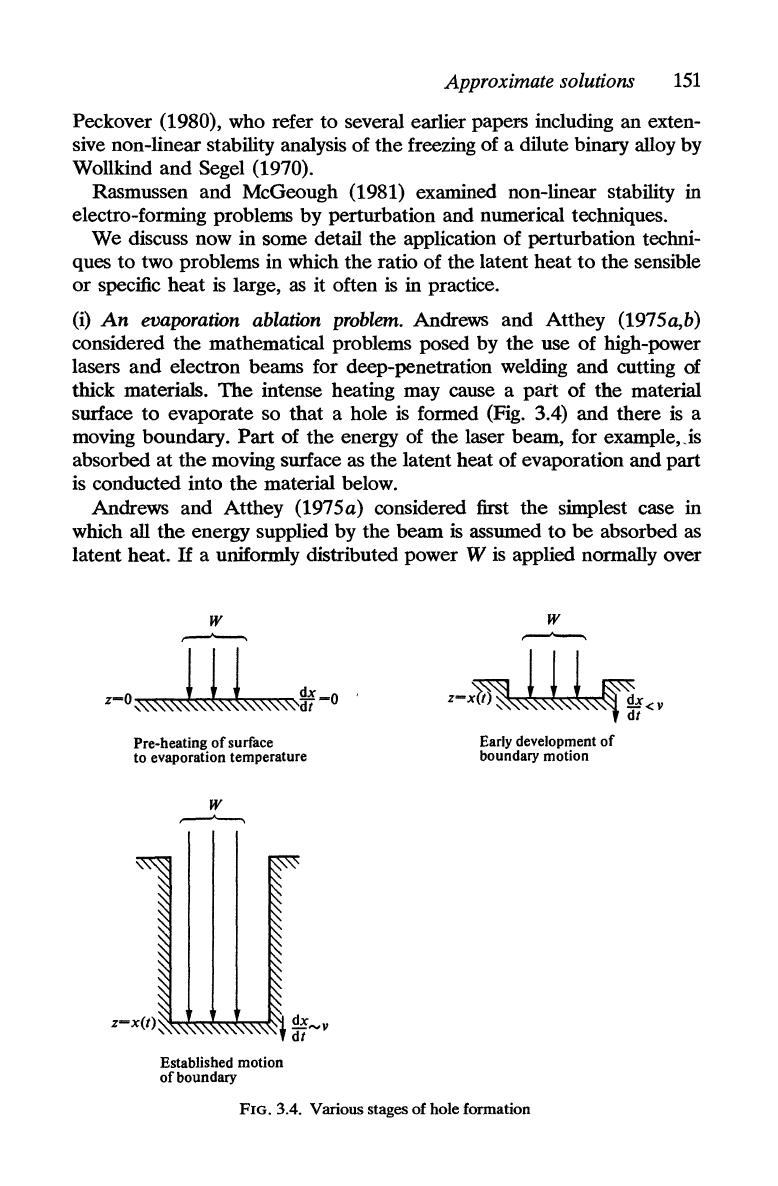
Approximate solutions
151
Peckover (1980), who refer to several earlier
paper-s
including an exten-
sive non-linear stability analysis of
the
freezing of a dilute binary alloy by
Wollkind and Segel (1970).
Rasmussen and McGeough (1981) examined non-linear stability in
electro-forming problems by perturbation and numerical techniques.
We discuss now in some detail the application of perturbation techni-
ques
to
two problems in which the ratio of the latent heat
to
the sensible
or specific
heat
is
large, as it often
is
in practice.
(i)
An
evaporation ablation
problem.
Andrews and Atthey (1975a,b)
considered
the
mathematical problems posed by the use of high-power
lasers
and
electron beams for deep-penetration welding and cutting of
thick materials.
The
intense heating may cause a part of the material
surface
to
evaporate so that a hole
is
formed (Fig. 3.4) and there
is
a
moving boundary.
Part
of the energy of the laser beam, for example,js
absorbed at
the
moving surface as the latent heat of evaporation and part
is conducted into
the
material below.
Andrews and Atthey
(1975a) considered first the simplest case
in
which all
the
energy supplied by the beam
is
assumed
to
be
absorbed as
latent heat. H a uniformly distributed power W
is
applied normally over
w
,.---"-.
~~%~~-M-<l
Pre-heating
of
surface
to evaporation temperature
Established motion
of
boundary
w
z-x~
I I I
~~<v
rW~I
Early development
of
boundary motion
FIG. 3.4. Various stages of hole formation
